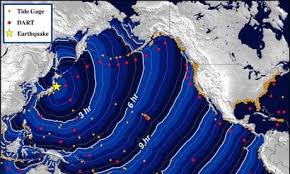Japan is one of the most earthquake-prone countries on Earth, experiencing thousands of tremors every year, ranging from mild shakes to catastrophic q
Japan is one of the most earthquake-prone countries on Earth, experiencing thousands of tremors every year, ranging from mild shakes to catastrophic quakes that trigger devastating tsunamis. Its unique position along major tectonic boundaries has made it a natural laboratory for studying Earth’s geological processes — but also a region of persistent seismic risk.
This article explores the scientific reasons behind Japan earthquakes and tsunamis, examining the tectonic forces at play, how undersea quakes generate massive waves, and what Japan has done to minimize damage from these natural disasters.
What Geological Factors Make Japan Earthquake-Prone?
Japan’s vulnerability to earthquakes stems from its location along the Pacific Ring of Fire, a 40,000-kilometer belt of intense seismic and volcanic activity encircling the Pacific Ocean. Within this region, several massive tectonic plates collide and shift, releasing enormous amounts of energy through earthquakes. Japan sits at the intersection of four major tectonic plates:
- The Pacific Plate
- The Philippine Sea Plate
- The Eurasian Plate
- The North American Plate
The Pacific and Philippine Sea Plates are oceanic plates that constantly move westward, sliding beneath the continental Eurasian and North American Plates in a process known as subduction. This creates deep-sea trenches like the Japan Trench, where the plates meet.
When pressure between these colliding plates builds up, it releases as an earthquake. These subduction zones often produce megathrust earthquakes, the most powerful type on Earth. They not only shake the ground but can also displace vast amounts of ocean water — generating tsunamis. Japan’s position on multiple active boundaries makes it a global hotspot for seismic activity.
How Do Earthquakes Trigger Tsunamis in Japan?
A tsunami is a series of massive waves caused by sudden displacement of water, typically due to undersea earthquakes. When the sea floor shifts upward or downward during a quake, it pushes or pulls the water above, creating waves that radiate outward.
As these waves cross the ocean, they may seem small, but near the coast, they rise dramatically in height. Japan’s narrow islands and deep trenches make it highly vulnerable to tsunami effects.
The 2011 Tōhoku earthquake and tsunami (magnitude 9.0) was one of the strongest ever recorded. Waves over 40 meters high devastated coastal towns, claimed more than 18,000 lives, and triggered the Fukushima Daiichi nuclear disaster.
Since then, Japan has implemented key safety improvements:
- Early warning systems that detect undersea quakes and issue alerts in seconds
- Coastal barriers and tsunami walls in high-risk areas
- Regular evacuation drills and public education campaigns
These measures reflect Japan’s strong commitment to minimizing the impact of future Japan tsunami events.
Additional Factors Affecting Japan’s Seismic Risk
- Mountainous Terrain: Intensifies ground shaking and triggers landslides.
- Coastal Geography: Japan’s long coastline funnels waves, amplifying tsunamis.
- Urban Density: Coastal megacities like Tokyo and Osaka are at higher risk due to soft soil and reclaimed land.
Despite these challenges, Japan’s earthquake-resistant architecture is among the world’s best. Buildings in Tokyo are designed with flexible foundations that absorb seismic energy.
Japan also leads in earthquake and tsunami research, with the Japan Meteorological Agency (JMA) monitoring activity through nationwide sensors and ocean buoys. Continuous research helps refine prediction models and improve disaster preparedness.
Conclusion
Frequent Japan earthquakes and tsunamis are the result of its location on the active Pacific Ring of Fire, where tectonic plates collide and reshape the Earth’s crust. While these geological processes pose dangers, they have also driven Japan to pioneer some of the most advanced disaster preparedness systems in the world.
Japan’s resilience offers a global lesson in adaptation and innovation — a reminder that understanding nature’s power is the first step to living safely with it.
Frequently Asked Questions (FAQ)
- Why does Japan have so many earthquakes?
Japan lies at the junction of four tectonic plates, making it one of the most seismically active regions on Earth. - What causes tsunamis in Japan?
Most tsunamis occur after powerful undersea earthquakes displace large volumes of water. - How does Japan prepare for earthquakes and tsunamis?
Through early warning systems, strict building codes, and nationwide evacuation drills. - What was the impact of the 2011 Tōhoku tsunami?
It caused over 18,000 deaths, massive infrastructure loss, and the Fukushima nuclear disaster.


COMMENTS